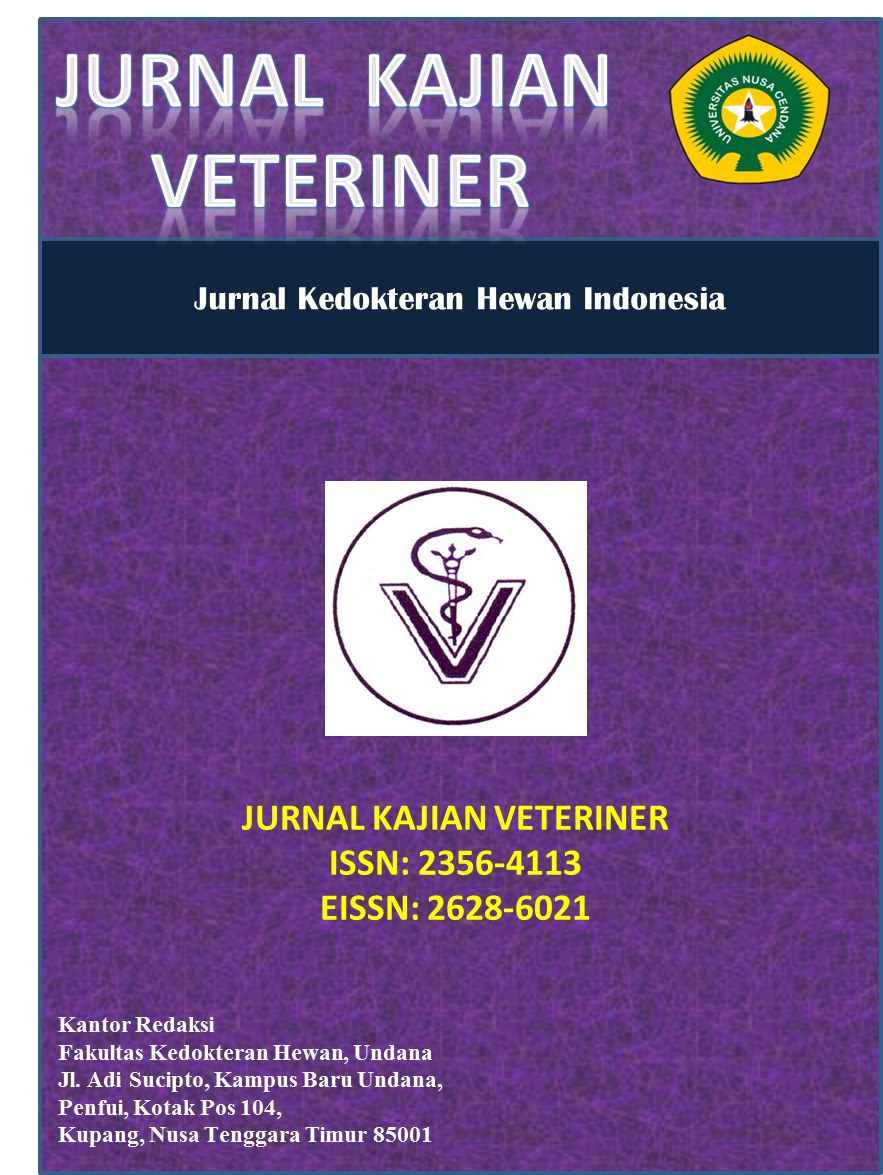SENSITIVITAS ANTIMIKROBA TERHADAP BAKTERI ESCHERICHIA COLI YANG DIISOLASI DARI UDANG DI PASAR KEPUTRAN SURABAYA
Abstract
The aimed of this study was to identify antibiotic Resistance of Escherichia coli isolated from Shrimp. There were 20 samples taken and isolated on surface of Eosin Methilen Blue Agar. E.coli produced metalic green colonies. Samples identified as E.coli based on macroscopic features and morphology of colonies, microscopic examination with gram staining and biochemical tests. The antibiotic sensitivity was determined through a standard antimicrobial disk diffusion test. The results of this study showed that 9 samples were bacteria of the spesies E. coli. Based on the results of antibiotic sensitivity test, it was found that 100 % of E. coli isolates were resistant to Amoxycillin 20 µg and 22,2 % of isolates are resistant to ampicillin 10 µg. Antibiotics Tetracycline 30 µg and Chloramphenicol 30 µg were 100 % sensitive. Gentamicin 10 µg showed that 77,8 % sensitive and 22,2 % intermediet. The precence of antibiotic resistance of betalaktam antibiotics makes it especially important to monitor antimicrobial susceptibility and mechanisms of resistance of E.coli isolated from shrimp, because new mechanisms of resistance occurring in animals may enter the food chain and its be transferred to the human. This importance of cooperation between sectors in order to monitor antimicrobial resistance.
Downloads
References
Chakravarty MS, Ganesh PRC, Amaranth D, Sudha BS, Subhashini. 2015. Escherichia coli – Occurence in The Meat of Shrimp, Fish, Chicken and Mutton and its Antibiotic Resistance. European Journal of Experimental Biology. 5(7): 41-48.
Clinical and Laboratory Standart Institute. 2007. Performance standarts for Antimicrobial Susceptibility. http://ljzx.cqrmhospital.com/upfiles/201601/20160112155335884.pdf diunduh pada 2 Oktober 2019.
El-Olemy GM, Lobna MA, Salem No, Khalifa MS. 2014. Detection of Some Bacterial Zoonosis in Market Fish in Qolyoubia Province and Their Control. Benha Veterinary Medicine Journal. 26(2): 126-136.
Emikpe BO, Adebisi T, Adedeji OB. 2011. Bacteria Load on The Skin and Stomach of Clarias Gariepinus and Oreochromis Niloticus from Ibadan, South West Nigeria: Public Health Implications. J. Microbiol. Biotech. Res. 1(1): 52-59.
Hossain MS, Aktaruzzaman M, Fakhruddin ANM, Uddin MJ, Rahman SH, Chowdhury MAZ, Alam MK. 2012. Prevalence of Multiple Drug Resistant Pathogenic Bacteria in Cultured Black Tiger Shrimp (Penaeus monodon Fabricius). Global Jounal of Environmental Research. 6(3):118-124.
Johnson J, Kuskowski M, Menard M, Gajewski A, Xercavins M, Garau J. 2006. Similarity between human and chicken Escherichia coli isolates in relation to ciprofloxacin resistance status. J. Infect. Dis. 194(1): 71 - 78
Markey B, Leonard F, Archambault M, Cullinane A, Maguire D. 2013. Clinical Veterinary microbiology 2nd edition. London. Pp 253 – 255.
Mary SJAJ, Dhayanath M, Paul T. 2019. Prevalence and Characteriztion of Antibiotic Resistance Associated with Escherichia coli Isolated from Cultured Penaeus vannamei from Maharashtra, India. International Journal of Current Microbiology and Applied Sciences. 8(7): 1790 -1797.
Pormohammad A, Nasiri MJ, Azimi T. 2019. Prevalence of Antibiotic Resistance in Escherichia coli Strains Simultaneously Isolated from Humans, Animals, Food, and The Environment: a Systematic Review and Meta-Analysis. Infection and Drug Resistance. 12: 1181 – 1197.
Pratiwi R. 2008. Aspek Biologi Udang Ekonomis Penting. Oceana 33(2): 15 – 24.
Reygaert WC, 2017. Antimicrobial Mechanism of Escherichia coli. 81- 97.
Rocha RD, Leite LO, Sousa OVD, Vieira RHS. 2014. Antimicrobial Susceptibility of Escherichia coli Isolated from Fresh-Marketed Nile Tilapia (Oreochromis miloticus). Jounal of Pathogens. 2014: 1-5.
Samia S, Galib HT, Tanvir AS, Basudeb CS, Walliullah Md, Tasnia A, Sakil Md, Afsana FN, Sadia KP, Kamal KD, Mrityunjoy A, Nusrat JU, Tasmina R, Rashed N. 2014. Microbiological Quality Analysis of Shrimps Collected from Local Around Dhaka City. International Food Research Journal. 21(1): 33-38.
Sari R, Apridamayanti P, Puspita ID. 2018. Sensitivity of Escherichia coli Bacteria Towards Antibiotics in Patient with Diabetic Foot Ulcer. Pharmaceutical Sciences and Research. 5(1): 19-24.
Shoki NM, Mahmoud Aml, Ibrahim MS. 2018. Detection of E.coli in Nile Tilapia from Retail in Gharbiya Governorate. Alexandria Journal of Veterinary Sciences. 59(1): 76-84
Vieira RHSF, Carvalho EMR, Carfalho FCT, Silva CM, Sousa OV, Rodrigues DP. 2010. Antimicrobial Susceptibility of Escherichia coli Isolated From Shrimp (Litopenaeus vannamei) and Pond Environment in Northeastern Brazil. Journal of Environmental Science and Health, Part B. 45(3): 198-203.
Copyright (c) 2020 JURNAL KAJIAN VETERINER

This work is licensed under a Creative Commons Attribution-NonCommercial-NoDerivatives 4.0 International License.

 Reina Puspita Rahmaniar(1*)
Reina Puspita Rahmaniar(1*)








.png)


